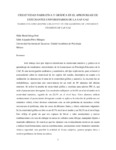
Please use this identifier to cite or link to this item:
http://ricaxcan.uaz.edu.mx/jspui/handle/20.500.11845/647Full metadata record
| DC Field | Value | Language |
|---|---|---|
| dc.contributor | 220210 | es_ES |
| dc.contributor | 825574 | es_ES |
| dc.coverage.spatial | Estudiantes psicología UAZ | es_ES |
| dc.creator | Ortega Neri, Hilda María | - |
| dc.creator | Pérez Márquez, Edith Alejandra | - |
| dc.date.accessioned | 2018-10-16T15:17:40Z | - |
| dc.date.available | 2018-10-16T15:17:40Z | - |
| dc.date.issued | 2018-09-26 | - |
| dc.identifier | info:eu-repo/semantics/publishedVersion | es_ES |
| dc.identifier.isbn | 978-9962-5571-4-2 | es_ES |
| dc.identifier.uri | http://hdl.handle.net/20.500.11845/647 | - |
| dc.description | The objective of this work was to determine the narrative and graphic creativity in the learning of university students of the Bachelor in Educational Psychology of the UAZ. It is a qualitative and quantitative research, of the exploratory type, because the approach was about the creativity of the subjects of the study, descriptive in terms of the reality of the students in the theme of graphic and narrative creativity. The sample was non-probabilistic, subject-type for convenience of a total of 89 students of the tenth semester. The PIC-A adult graphic and writing creativity test was used, which measures divergent thinking. The results reflected a 64.0% in the medium level in the narrative creativity, followed by a 22.5% in the low level. These students use moderately divergent thinking when applied to the solution of problems with verbal content, offers various solutions to a single problem of a verbal nature, restructures the problem, looks at things in different ways and offers original solutions. In graphic creativity, 42.7% was obtained in the medium level and 38.2% in the low level. This reflects the degree to which they are able to carry out associations and new combinations when working on non-verbal tasks such as drawing, manipulating objects or didactic materials. It is concluded that the students are eventually creative in terms of making transformations, new combinations, associations between mental elements, relative ability to perceive reality in a subjective way, generate their own ideas or solve problems in a novel way. | es_ES |
| dc.description.abstract | Este trabajo tuvo por objetivo determinar la creatividad narrativa y gráfica en el aprendizaje de estudiantes universitarios de la Licenciatura en Psicología Educativa de la UAZ. Es una investigación cualitativa y cuantitativa, del tipo exploratorio, pues se buscó el acercamiento sobre la creatividad de los sujetos del estudio, descriptiva en cuanto a la realidad de los alumnos en el tema de la creatividad gráfica y narrativa. La muestra fue no probabilística, sujetos-tipo por conveniencia de un total de 89 alumnos del décimo semestre. Se utilizó la prueba de creatividad gráfica y escritura para adultos PIC-A, que mide el pensamiento divergente. Los resultados reflejaron un 64.0% en el nivel medio en la creatividad narrativa, seguido de un 22.5% en el nivel bajo. Estos alumnos utilizan medianamente el pensamiento divergente cuando se aplica a la solución de problemas con contenido verbal, ofrece diversas soluciones ante un solo problema de naturaleza verbal, reestructura el problema, mira las cosas de diferente forma y ofrece soluciones originales. En la creatividad gráfica se obtuvo un 42.7% en el nivel medio y un 38.2% en el nivel bajo. Esto refleja el grado en que son capaces de llevar a cabo asociaciones y nuevas combinaciones a la hora de trabajar en tareas no verbales como dibujar, manipular objetos o materiales didácticos. Se concluye que los alumnos son eventualmente creativos en cuanto a realizar transformaciones, nuevas combinaciones, asociaciones entre elementos mentales, relativa capacidad para percibir la realidad de forma subjetiva, generar propias ideas o resolver problemas de forma novedosa. | es_ES |
| dc.language.iso | spa | es_ES |
| dc.publisher | Psychology Investigation | es_ES |
| dc.relation.uri | generalPublic | es_ES |
| dc.rights | Atribución-NoComercial-CompartirIgual 3.0 Estados Unidos de América | * |
| dc.rights.uri | http://creativecommons.org/licenses/by-nc-sa/3.0/us/ | * |
| dc.source | VII Congreso Internacional de Psicología y Educación. del 25 al 28 de septiembre de 2018, Santa Marta. Colombia | es_ES |
| dc.subject.classification | HUMANIDADES Y CIENCIAS DE LA CONDUCTA [4] | es_ES |
| dc.subject.other | Creatividad narrativa | es_ES |
| dc.subject.other | Creatividad gráfica | es_ES |
| dc.subject.other | Estudiantes universitarios | es_ES |
| dc.title | Creatividad narrativa y gráfica en el aprendizaje de estudiantes universitarios de la UAP-UAZ | es_ES |
| dc.type | info:eu-repo/semantics/conferenceObject | es_ES |
| Appears in Collections: | *Documentos Académicos*-- UA Psicología | |
Files in This Item:
| File | Description | Size | Format | |
|---|---|---|---|---|
| Ortega Neri, Ponencia, Psicología.pdf | 254,94 kB | Adobe PDF |  View/Open |
This item is licensed under a Creative Commons License
